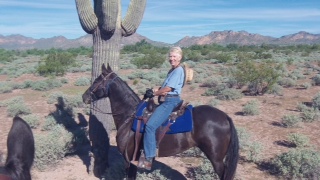Ann Richards, Equestrian Trail Steward for the Superstition Area Land Trust (S.A.L.T.)
As an Equestrian Trail Steward for the Superstition Area Land Trust (S.A.L.T.), I luckily get to combine my love of horseback riding with my love of the Superstition Wilderness. Dividing my time between Iowa and Arizona allows me to enjoy my sport year round. I travel to Arizona in September when the cooler temperatures arrive in Iowa, and return to Iowa in early May when the temperatures start to heat up in Arizona.
In 2014, SALT initiated the Trail Steward Program to promote safety and education on the Silly Mountain and Lost Goldmine Trails. While hiking the trails, trail stewards answer questions about the trails as well as providing assistance to hikers that find themselves in need while hiking the trails. As an avid horseback rider with many years of experience, I was pleased to learn that S.A.L.T. was welcoming equestrians into the Trail Steward Program. The initial training that I received under the new program provided me with the opportunity to promote safety on the trails as well as educating hikers about the Superstition Wilderness and horses.
A day of horseback riding in the Superstition Wilderness is very different from horseback riding at my summer home in Iowa. When patrolling the Silly Mountain Trail, I ride one of my two Tennessee Walking horses (Dolly or Glory) from my stables to the east side of the mountain and them greet people in the parking lot. Patrolling the Lost Gold Mine Trail, requires me to trailer one of my horses to the parking lot located at the end of Cloudview Rd., and from there I will ride the entire length of the trail approximately 6 miles in each direction. On these days, I have a lite lunch all while enjoying the the beautiful landscape.
I have enjoyed being a mounted trail steward; it has been a great way of greeting people and answering questions about the trails. Some hikers ask to pet the horses while others want to keep their distance from the big 4-legged fury things! Occasionally someone will complain that horses leave “road apples” on the trails; I reply, “yes those are a by-product of horses, but are totally biodegradable!”
For individuals reading this article that are interested in becoming an equestrian trail steward, please consider the following:
· Horses must be able to stand for long periods of time in case an emergency is encountered on the trail
· Horses must be comfortable with sharing the trails with bikers and hikers
· Not all trails are open to horses
· Horses must stay on designated trails and roads
· Riders need to let hikers and bikers know when it is safe to pass your horse
· Use weed free hay to avoid spreading non-native plants
When a biker approaches a horse on the trail, the biker should talk to the horse as horses are familiar with voices, but not the silent approach of bikes. I always ask bikers to talk to my horse so each becomes familiar with the other. In general, proper trail etiquette suggest that hikers and bikers yield to horses and hikers yield to bikers. There are times when it may be more suitable for horses to yield to hikers or bikers; it all boils down to “common sense.”

